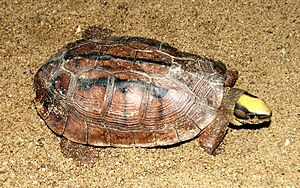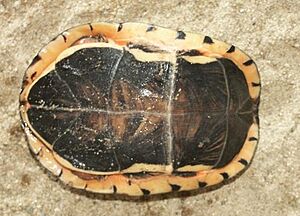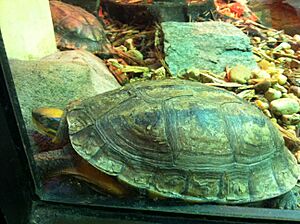Golden coin turtle facts for kids
Quick facts for kids Golden coin turtle |
|
|---|---|
 |
|
| Conservation status | |
| Scientific classification | |
| Genus: |
Cuora
|
| Species: |
trifasciata
|
| Synonyms | |
|
|
The golden coin turtle (Cuora trifasciata) is a special type of turtle. It is also known as the Chinese three-banded box turtle. This turtle gets its name from the three dark stripes on its shell. It lives in southern China and is part of the Geoemydidae family. Sadly, this turtle is now critically endangered, meaning it is at a very high risk of disappearing forever.
Where Golden Coin Turtles Live
Golden coin turtles are found in China. They live on Hainan island and in Hong Kong. They used to live on the mainland in provinces like Guangdong and Guangxi. But now, they are no longer found there in the wild. Turtles found in Vietnam and Laos are actually a different but similar species.
What Golden Coin Turtles Look Like
The golden coin turtle has three clear black stripes on its brown upper shell, called a carapace. Its upper jaw is yellow and slightly curved. A yellow stripe also runs from the back of its mouth. The underside of its shell, called the plastron, is mostly black with a yellow edge. These turtles can grow up to 25 centimeters (about 10 inches) long.
Types of Golden Coin Turtles
Scientists recognize two main types, or subspecies, of the golden coin turtle:
- Cuora trifasciata luteocephala
- Cuora trifasciata trifasciata
These subspecies are slightly different from each other.
What Golden Coin Turtles Eat
In the wild, golden coin turtles mostly eat fish and frogs. They also eat dead animals. Sometimes, they eat crabs, snails, and insects too. They are not picky eaters!
Turtle Hybrids
Golden coin turtles can easily create hybrids. This happens when two different species have babies together. These hybrid turtles can even have their own babies. Some turtles that were once thought to be new species are actually hybrids of the golden coin turtle and other turtles. For example, the Fujian pond turtle is often a mix of a male golden coin turtle and a female Asian yellow pond turtle.
Protecting Golden Coin Turtles
The golden coin turtle is one of the most endangered turtles in the world. The IUCN (International Union for Conservation of Nature) says it is critically endangered. This means it faces a very high risk of becoming extinct.
One big reason they are in danger is because people hunt them. They are used in some traditional practices, like for a Chinese dessert called guīlínggāo. Because of this, too many turtles are caught from the wild. This makes it very hard for their populations to grow.
Turtle Farming
Some farms in China try to raise golden coin turtles. Farmers hope to meet the demand for these turtles without taking them from the wild. In 2003, a survey found that many farms had a lot of these turtles. They sold thousands of them each year. A farm-raised golden coin turtle can be very expensive, much more than other turtles.
However, there are problems with farming these turtles:
- Wild golden coin turtles are still worth more money to people who trade animals illegally.
- The temperature during incubation determines if a turtle egg becomes a male or female. On farms, the temperatures often lead to only female turtles being born. This makes wild male turtles even more valuable and hunted.
- Many farmed turtles are hybrids, meaning they are a mix of different turtle species. If these hybrids escape, they can mix with wild turtles. This can cause problems for the pure wild species.
One of the biggest turtle farms is in Boluo County, China. It started in 1989 with just eight wild turtles. Now, it has thousands of turtles. Farm-born turtles usually start having babies when they are about 8 years old.




